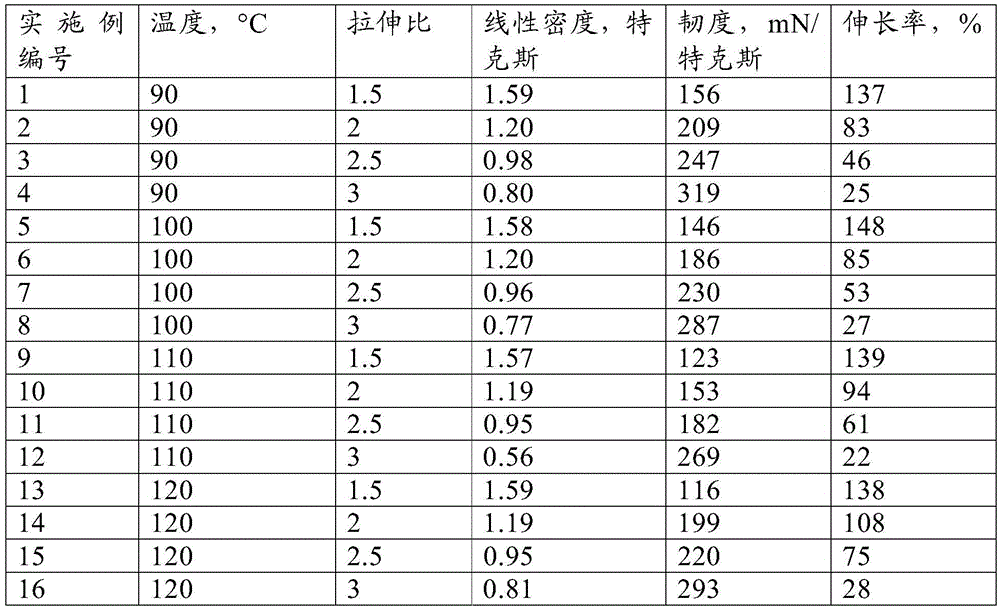Process for the preparation of a fiber, a fiber and a yarn made from such a fiber
A fiber and fiber-forming technology, applied in the field of fiber preparation, can solve the problem of not providing fiber parameters and the like
- Summary
- Abstract
- Description
- Claims
- Application Information
AI Technical Summary
Problems solved by technology
Method used
Image
Examples
Embodiment 1
[0041] A sample of polyethylene-2,5-furandicarboxylate (hereinafter referred to as "PEF") having a weight-average molecular weight Mw of 75,600 (corresponding to an intrinsic viscosity of 0.74 dl / g) was passed through 48°C at a temperature of 260°C. - Orifice spinneret melt spinning, the weight average molecular weight of which is determined by GPC using polystyrene standard substances. Cool the melt and spin. 48 filaments were combined into a yarn having a linear density of 115 tex, corresponding to a linear density of 2.40 tex / filament. The fracture toughness was 96 mN / tex and the elongation to break was 239% (both determined according to ISO 5079-1995). The yarn is stretched (drawn) to different draw ratios at different draw temperatures as spinning. The yarn had an IV of 0.67 dl / g, corresponding to a weight average molecular weight of 66,400. The resulting linear density / filament, fracture tenacity and elongation at break are shown in Table 1 below.
[0042] Table 1
...
Embodiment 2
[0046] The same polymer used in Example 1 was subjected to a two-step stretching (stretching) process. First, the polymer composition was melt-spun in the same manner as in Example 1. The resulting yarn was then preliminarily drawn at 85°C to a draw ratio of 2.5. In the second stage, the initially drawn fibers are further drawn to different final draw ratios in an oven heated to 125°C or 130°C. Tenacity and elongation were again determined for each of the resulting yarns. The results are shown in Table 2.
[0047] Table 2
[0048]
[0049]
[0050] The results show that after the first stretching step at a relatively low temperature, a second step at a higher temperature can be carried out, wherein said temperature change in the second step in the region of 125°C to 130°C is hardly effective. effect.
Embodiment 3
[0052] The same polymer used in Example 2 was used and melt spun in the same manner. In a first step, the spun fiber was drawn at 90°C to a first draw ratio of 2.4. The initially drawn fibers were then passed over a hot plate maintained at 100°C and further drawn to a final draw ratio in the range of 3 to 3.6. Table 3 shows the results of these tests.
[0053] table 3
[0054]
[0055] The results show that the tenacity of the resulting fibers increases when the stretching temperature in the second step is also at most 100°C. The yarn exhibits a melting point of 204°C-210°C. Yarn of Run No. 23 had a crystallinity of 14 J / g as determined by differential scanning calorimetry (DSC) from the net enthalpy of fusion. The crystallinity of the yarn of test number 26 was 30 J / g.
PUM
| Property | Measurement | Unit |
|---|---|---|
| crystallinity | aaaaa | aaaaa |
| melting point | aaaaa | aaaaa |
| melting point | aaaaa | aaaaa |
Abstract
Description
Claims
Application Information
 Login to View More
Login to View More - R&D
- Intellectual Property
- Life Sciences
- Materials
- Tech Scout
- Unparalleled Data Quality
- Higher Quality Content
- 60% Fewer Hallucinations
Browse by: Latest US Patents, China's latest patents, Technical Efficacy Thesaurus, Application Domain, Technology Topic, Popular Technical Reports.
© 2025 PatSnap. All rights reserved.Legal|Privacy policy|Modern Slavery Act Transparency Statement|Sitemap|About US| Contact US: help@patsnap.com



